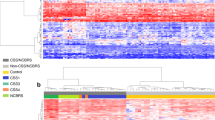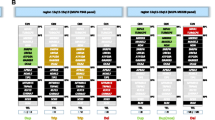Abstract
Prader-Willi (PWS) and Angelman (AS) syndromes are clinically distinct neurodevelopmental genetic diseases with multiple phenotypic manifestations. They are one of the most common genetic syndromes caused by non-Mendelian inheritance in the form of genomic imprinting, and can be attributable to the loss of gene expression due to imprinting within the chromosomal region 15q11-q13. Clinical diagnosis of PWS and AS is challenging, and the use of molecular and cytomolecular studies is recommended to help in determining the diagnosis of these conditions. The methylation analysis is a sensible approach; however there are several techniques for this purpose, such as the methylation-sensitive polymerase chain reaction (MS-PCR). This study aims to optimize the MS-PCR assay for the diagnosis of potential PWS and AS patients using DNA modified by sodium bisulfite. We used the MS-PCR technique of PCR described by Kosaki et al. (1997) adapted with betaine. All different concentrations of betaine used to amplify the methylated and unmethylated chromosomal region 15q11-q13 on the gene SNRPN showed amplification results, which increased proportionally to the concentration of betaine. The methylation analysis is a technically robust and reproducible screening method for PWS and AS. The MS-PCR assures a faster, cheaper and more efficient method for the primary diagnosis of the SNRPN gene in cases with PWS and AS, and may detect all of the three associated genetic abnormalities: deletion, uniparental disomy or imprinting errors.



Similar content being viewed by others
References
Santa María VL, Curotto LB, Cortés MF, Rojas BC, Alliende RMA (2001) Diagnóstico molecular de los síndromes de Prader-Willi y de Angelman: análisis de metilación, citogenética y FISH. Revista médica de Chile 129(4):367–374. doi:10.4067/s0034-98872001000400004
Hamzi K, Nadifi S, Itto A, Nassereddine S (2010) Prader-Willi syndrome: methylation study or fluorescence in situ hybridization first? Indian J Hum Genet 16(3):172. doi:10.4103/0971-6866.73417
Ramsden SC, Clayton-Smith J, Birch R, Buiting K (2010) Practice guidelines for the molecular analysis of Prader-Willi and Angelman syndromes. BMC Med Genet 11(1):70. doi:10.1186/1471-2350-11-70
Mutirangura A, Greenberg F, Mg Butler, Malcolm S, Nicholls Rd, Chakravarti A (1993) Multiplex PCR of three dinucleotide repeats in the Prader-Willi/Angelman critical region(15q11–q13): molecular diagnosis and mechanism on uniparental disomy. Hum Mol Genet 2:143–151
Nicholls RD (1993) Genomic imprinting and candidate genes in Prader-Willi and Angelman syndromes. Curr Opin Genet 3:445–456
Nicholls Rd (2000) Mosaicism in Prader-Willi syndrome. Am J Med Genet 90:175–176
Dagli AI, Mueller J, Williams CA.(1998) Angelman Syndrome. [Updated 2015 May 14]. In: Pagon RA, Adam MP, Ardinger HH, et al., (Eds.). GeneReviews® [Internet]. Seattle (WA): University of Washington, Seattle; 1993–2016. http://www.ncbi.nlm.nih.gov/books/NBK1144/
Dfd Carvalho, Cercato C, Mq Almeida, Mc Mancini, Halpern A (2007) Therapeutical approach of obesity in Prader-Willi Syndrome. Arch Endocrinol Metab 51(6):913–919
Rl Schalock, Ra Luckasson, Ka Shogren, Borthwick-Duffy S, Bradley V, Buntinx Wh (2007) The renaming of mental retardation: understanding the change to the term intellectual disability. Intellect Dev Disabil 45(2):116–124
Cassidy SB, Schwartz S, Miller JL, Driscoll DJ (2012) Prader-Willi syndrome. Genet Med 14(1):10–26. doi:10.1038/gim.0b013e31822bead0
Driscoll DJ, Miller JL, Schwartz S, et al. (1998) Prader-Willi Syndrome. [Updated 2014 Jan 23]. In: Pagon RA, Adam MP, Ardinger HH, et al., (Eds.). GeneReviews® [Internet]. Seattle (WA): University of Washington, Seattle; 1993–2016. http://www.ncbi.nlm.nih.gov/books/NBK1330/?report=classic
ASHG/ACMG (1996) Diagnostic testing for Prader-Willi and Angleman syndromes: report of the ASHG/ACMG test and technology transfer committee. Am J Hum Genet 58(5):1085–1088
White HE (2006) Quantitative analysis of SRNPN gene methylation by pyrosequencing as a diagnostic test for Prader-Willi syndrome and Angelman syndrome. Clin Chem 52(6):1005–1013. doi:10.1373/clinchem.2005.065086
Kubota T, Das S, Christian SL, Baylin SB, Herman JG, Ledbetter DH (1997) Methylation-specific PCR simplifies imprinting analysis. Nat Genet 16(1):16–17
Zeschnigk M, Lich C, Buiting K, Doerfler W, Horsthemke B (1997) A single-tube PCR test for the diagnosis of angelman and Prader-Willi syndrome based on allelic methylation differences at the SNRPN locus. Eur J Hum Genet 5(2):94–98
Zeschnigk M, Schmitz B, Dittrich B, Buiting K, Horsthemke B, Doerfler W (1997) Imprinted segments in the human genome: different DNA methylation patterns in the Prader-Willi/Angelman syndrome region as determined by the genomic sequencing method. Hum Mol Genet 6(3):387–395
Pratyush DD, Tiwari S, Kumar A, Singh SK (2012) A new approach to touch down method using betaine as co-solvent for increased specificity and intensity of GC rich gene amplification. Gene 497(2):269–272. doi:10.1016/j.gene.2012.01.031
Saluto A, Brussino A, Tassone F, Arduino C, Cagnoli C, Pappi P, Hagerman P, Migone N, Brusco A (2005) An enhanced Polymerase chain reaction assay to detect pre- and full mutation alleles of the fragile X mental retardation 1 gene. J Mol Diagn 7(5):605–612. doi:10.1016/s1525-1578(10)60594-6
Ralser M, Querfurth R, Warnatz H-J, Lehrach H, Yaspo M-L, Krobitsch S (2006) An efficient and economic enhancer mix for PCR. Biochem Biophysical Res Commun 347(3):747–751. doi:10.1016/j.bbrc.2006.06.151
Meguid NA, Ismail MF, El-Mahdy RS, Barakat MA, El-Awady MK (2014) Simple molecular diagnostic method for fragile X syndrome in Egyptian patients: pilot study. Acta Biochim Pol 61(2):259–263
Todorov T, Todorova A, Georgieva B, Mitev V (2010) A unified rapid PCR method for detection of normal and expanded trinucleotide alleles of CAG repeats in Huntington chorea and CGG repeats in fragile X syndrome. Mol Biotechnol 45(2):150–154. doi:10.1007/s12033-010-9260-y
Sarkar G, Kapelner S, Sommer SS (1990) Formamide can dramatically improve the specificity of PCR. Nucleic Acids Res 18(24):7465
McConlogue L, Brow MA, Innis MA (1988) Structure-independent DNA amplification by PCR using 7-deaza-2′-deoxyguanosine. Nucleic Acids Res 16(20):9869
Chakrabarti R, Schutt CE (2002) Novel sulfoxides facilitate GC-rich template amplification. Biotechniques 32:866–874
Bhagya CH, Wijesundera Sulochana WS, Hemamali NP (2013) Polymerase chain reaction optimization for amplification of Guanine-Cytosine rich templates using buccal cell DNA. Indian J Hum Genet 19(1):78–83. doi:10.4103/0971-6866.112898
Kosaki K, McGinniss MJ, Veraksa AN, McGinnis WJ, Jones KL (1997) Prader-Willi and Angelman syndromes: diagnosis with a bisulfite-treated methylation-specific PCR method. Am J Med Genet 73(3):308–313. doi:10.1002/(SICI)1096-8628(19971219)73:3<308:AID-AJMG15>3.0.CO;2-N
Dikow N, Nygren AOH, Schouten JP, Hartmann C, Krämer N, Janssen B, Zschocke J (2007) Quantification of the methylation status of the PWS/AS imprinted region: comparison of two approaches based on bisulfite sequencing and methylation-sensitive MLPA. Mol Cell Probes 21(3):208–215. doi:10.1016/j.mcp.2006.12.002
Tassone F, Pan R, Amiri K, Taylor AK, Hagerman PJ (2008) A rapid polymerase chain reaction-based screening method for identification of all expanded alleles of the fragile X (FMR1) gene in newborn and high-risk populations. J Mol Diagn 10(1):43–49. doi:10.2353/jmoldx.2008.070073
Henke W, Herdel K, Jung K, Schnorr D, Loening SA (1997) Betaine improves the PCR amplification of GC-rich DNA sequences. Nucleic Acids Res 25(19):3957–3958
Invitrogen C (Rev. 2010) Platinum® Taq DNA Polymerase [catalog]. http://www.lifetechnologies.com/content/dam/LifeTech/migration/files/pcr/pdfs.par.26652.file.dat/platinumtaq-pps.pdf
Biosystems A (2008) Amplification of long GC-rich sequences—AmpliTaq Gold® 360 master mix. Publication 121AP01-01. https://tools.thermofisher.com/content/sfs/brochures/cms_060635.pdf
Dittrich B, Robinson WP, Knoblauch H, Buiting K, Schmidt K, Gillessen-Kaesbach G, Horsthemke B (1992) Molecular diagnosis of the Prader-Willi and Angelman syndromes by detection of parent-of-origin specific DNA methylation in 15q11–13. Hum Genet 90(3):313–315
Kubota T, Sutcliffe JS, Aradhya S, Gillessen-Kaesbach G, Christian SL, Horsthemke B, Beaudet AL, Ledbetter DH (1996) Validation studies of SNRPN methylation as a diagnostic test for Prader-Willi syndrome. Am J Med Genet 66(1):77–80
Velinov M, Gu H, Genovese M, Duncan C, Brown WT, Jenkins E (2000) The feasibility of PCR-based diagnosis of Prader-Willi and Angelman syndromes using restriction analysis after bisulfite modification of genomic DNA. Mol Genet Metab 69(1):81–83
Muralidhar B, Butler MG (1998) Methylation PCR analysis of Prader-Willi syndrome, Angelman syndrome, and control subjects. Am J Med Genet 80(3):263–265
Horsthemke B, Lich C, Buiting K, Achmann R, Aulehla-Scholz C, Baumer A, Bürger J, Dworniczak B, Gläser D, Holinski-Feder E, Janssen B, Kleinle S, Kochhan L, Krasemann E, Kraus C, Kroisel P, Plendl H, Purmann S, Sander G, Skladny H, Spitzer E, Thamm-Mücke B, Varon-Mateeva R, Weinhäusel A, Weirich H (2003) Problems in detecting mosaic DNA methylation in Angelman syndrome. Eur J Hum Genet 11(12):913–915
Buchholz T, Jackson J, Robson L, Smith A (1998) Evaluation of methylation analysis for diagnostic testing in 258 referrals suspected of Prader-Willi or Angelman syndromes. Hum Genet 103(5):535–539
Tzagkaraki E, Sofocleous C, Fryssira-Kanioura H, Dinopoulos A, Goulielmos G, Mavrou A, Kitsiou-Tzeli S, Kanavakis E (2013) Screening of UBE3A gene in patients referred for Angelman Syndrome. Eur J Paediatr Neurol 17(4):366–373. doi:10.1016/j.ejpn.2012.12.010
Buller A, Pandya A, Jackson-Cook C, Bodurtha J, Tekin M, Wilkinson DS, Garrett CT, Ferreira-Gonzalez A (2000) Validation of a multiplex methylation-sensitive PCR assay for the diagnosis of Prader-Willi and Angelman’s syndromes. Mol Diagn 5(3):239–243
Author information
Authors and Affiliations
Corresponding author
Rights and permissions
About this article
Cite this article
dos Santos, J.F., Mota, L.R., Rocha, P.H.S.A. et al. A modified MS-PCR approach to diagnose patients with Prader-Willi and Angelman syndrome. Mol Biol Rep 43, 1221–1225 (2016). https://doi.org/10.1007/s11033-016-4055-2
Received:
Accepted:
Published:
Issue Date:
DOI: https://doi.org/10.1007/s11033-016-4055-2




